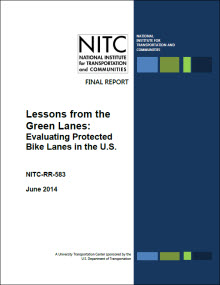 Portland State University's National Institute of Transportation and Communities released a report that evaluates U.S. protected bicycle lanes (cycle tracks) in terms of their use, perception, benefits, and impacts. The research examined protected bicycle lanes in Austin, TX; Chicago, IL; Portland, OR; San Francisco, CA; and Washington, D.C. using video, surveys of intercepted bicyclists and nearby residents, and count data.
Portland State University's National Institute of Transportation and Communities released a report that evaluates U.S. protected bicycle lanes (cycle tracks) in terms of their use, perception, benefits, and impacts. The research examined protected bicycle lanes in Austin, TX; Chicago, IL; Portland, OR; San Francisco, CA; and Washington, D.C. using video, surveys of intercepted bicyclists and nearby residents, and count data.
Count data indicates that ridership increased between 21 percent and 171 percent after the installation of the protected cycling facilities. Survey data shows that 10 percent of current riders switched from other modes and 24 percent shifted from other bicycle routes. Over a quarter of riders said they are riding more because of the protected bike lanes. Self-reported comfort levels were much higher for protected bike lanes than for standard striped bike lanes. Over 144 hours of video, which included 12,900 bicyclists, showed that there were no collisions or near-collisions on the protected bike lanes.